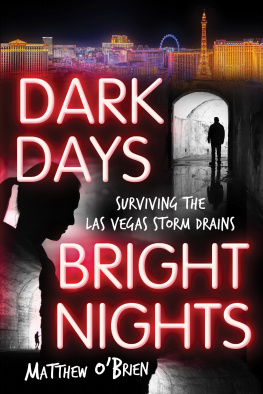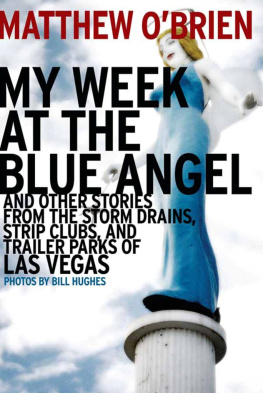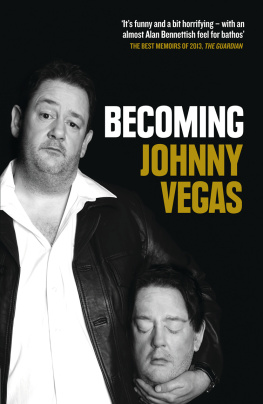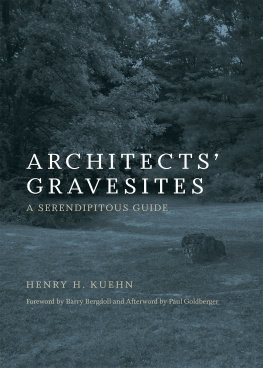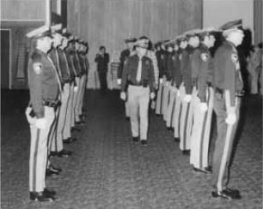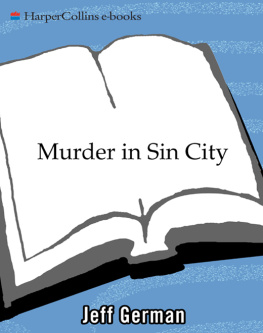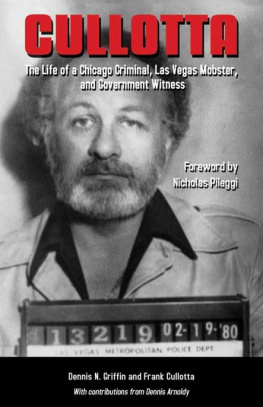Published by Huntington Press
3665 Procyon
Las Vegas, Nevada 89103
(702) 252-0655
(702) 252-0675 fax
books@huntingtonpress.com
Copyright 2007, Matthew OBrien
ISBN 978-0-929712-39-0
Design by Katherine Topaz, Topaz Design
Photos by Danny Mollohan, Bill Hughes
All rights reserved. No part of this publication may be translated, reproduced, or transmitted in any form or by any means, electronic or mechanical, including photocopying and recording, or by any information storage and retrieval system, without the express written permission of the copyright owner.
To the poets, artists, and madmen of the Las Vegas storm drains
ACKNOWLEDGMENTS
The people in the storm drains who shared their stories; Deke Castleman, Joshua Ellis, and my dad Matt; my mom Liz, my sisters Leslie and Cathy, my brother Eric, my sister-in-law Emily, my brother-in-law Pete, and David Dennis; Bill Hughes, Danny Mollohan, Joe Preston, and Kat Topaz; the Las Vegas CityLife staff and contributors, old and new; G.W. Fraser and Betty Hollister of the Clark County Regional Flood Control District; Lt. Tom Monahan of Metro Police; H. Lee Barnes, Bill Branon, Angela Brommel, Russ Cannon, Mark Danner, Adam Goldman, Michael Green, Kurt Harris, Jarret Keene, Chip Mosher, Brian Rouff, Cathy Scott, John L. Smith, Hunter S. Thompson, and Ingrid Truman; and Anthony Curtis, Bethany Coffey, Len Cipkins, and the rest of the Huntington Press staff.
AUTHORS NOTE
It all started in the summer of 2002, when I explored five storm drains with freelance writer Joshua Ellis. It culminated in the summer of 2004, when I took a sabbatical from Las Vegas CityLife, a weekly newspaper, and explored the flood-control system in full. It continued through 2006, as I returned to the drains for follow-up notes and to explore virgin tunnels. Beneath the Neon: Life and Death in the Tunnels of Las Vegaswhich is set in the long, hot, and lonely summer of 04chronicles my adventures in this uncharted underworld.
Matthew OBrien
December 31, 2006
CONTENTS
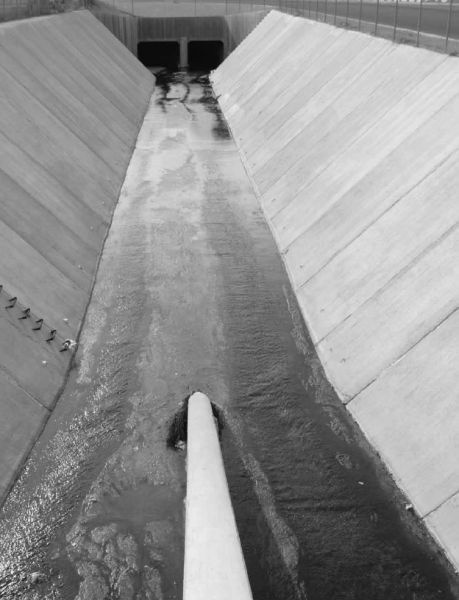
[INTRO] THE WEBER DRAIN
S tanding in front of the storm drain, a stream of runoff pressing against my boots, I felt as if a double-barreled shotgun was pointed at my head. My chest was tight. My heart beat violently. As I stared into the darkness, which seemed as deep as a midnight sky, chills shot down my spine and shook my soul. The drains two tunnels were each 12 feet wide and eight feet high, decorated with cobwebs and drooling algae. They exhaled mildewy air, which washed over me like bad breath.
I was at the bottom of a drainage ditch in downtown Las Vegas, just north of the Fremont Street Experience. The ditch was 20 feet deep, lined with concrete and surrounded by a barbwire fence (No Trespassing!). Ladder rungs jutted from the banks and flycatchers glided above the streamand the half-sunken plastic bags, Styrofoam cups, and aluminum cansswooping in and out of the tunnels. The sun, too, had spread its wings and was high in the sky. Late morning, it was already 90 degrees.
Exhaling, I slipped out of my backpack and unzipped the secondary pouch. It contained a tape recorder, four or five cassette tapes, a wire microphone, and fresh AA batteries. Removing the recorder, I placed it in a holster that hung from my hip and clipped the mike to the collar of my long-sleeve shirt. Then I ran the wire underneath the shirt, plugged it into the recorder, and pressed Play and Record.
Test one, test one, I said in a monotone voice. Weber Drain, Weber Drain.
I rewound the tape and pressed Play.
Test one, test one. Weber Drain, Weber Drain.
Next, I unzipped the backpacks main pouch. It contained a four-cell Mag-Lite flashlight, a Mini Mag-Lite, an expandable baton, a knit cap, and fresh D and AA batteries. I removed the Mini Mag-Lite and placed it in a pocket of my cargo pants. I stuffed the baton into a sheath in the small of my back and put on the cap. Finally, I clutched the Mag-Lite in my left handits hard steel cooling my palm and fingers.
In the late morning of April 14, 2002, Timmy T.J. Weber found himself in this same drainage ditch. A week and a half earlier, in a house on nearby First Street, Weber raped his girlfriends 14-year-old daughter and killed his girlfriend and one of her sons. Police discovered the girlfriends nude and bludgeoned body stuffed upside down in a storage container in a bedroom closet. A plastic bag secured with duct tape covered her head. Her 15-year-old son was found facedown on a mattress, his arms taped behind his back and a T-shirt stuffed in his mouth. He died of asphyxiation.
A morbid curiosity drew me to the ditch. I wondered what Weber experienced in the storm-drain system. What he saw, what he heard, what he smelled. How, apparently without a light source, hed splashed more than three miles upstream. Did clues of his escape route remain? Could he hear the police dogs barking overhead? The sirens screaming?
Following his carnival of crime, Weber left Las Vegasbut he soon returned. He ambushed his girlfriends surviving son and an adult companion when they ventured to the family home on First Street to retrieve mementos for the funerals. A riotous melee ensued, in which all three men sustained injuries. Weber fled on foot, bleeding from the forehead. He weaved around crumbling bungalows. He dashed across dirt yards, dogs barking in chorus. He then climbed the barbwire fence surrounding the drainage ditch and disappeared into the storm drain.
A morbid curiosity drew me to the ditch. I wondered what Weber experienced in the storm-drain system. What he saw, what he heard, what he smelled. How, apparently without a light source, hed splashed more than three miles upstream. Did clues of his escape route remain? Could he hear the police dogs barking overhead? The sirens screaming?
I also wondered what lurked beneath Las Vegas. Roman law forced Jews and Christians into a maze of catacombs. When surveyed by Pierre-Emmanuel Bruneseau and his staff in the early 1800s, the sewers of Paris yielded gold, jewels, and relics of the revolution. In the late 19th and early 20th centuries, a slave trade thrived in underground chambers along Portland, Oregons, waterfront. And thousands of people lived in the subway and train tunnels of New York City in the 1980s and 90s.
What secrets did the storm drains of Las Vegas keep? What discoveries waited in the dark? What was behind the black curtains?
Shuffling toward the north tunnel of the drain, I imagined Weber slamming into the fence and climbing it frantically. He balanced on the edge of the ditch, feeling for the rungs with a foot. A splash broke the silence. Kicking through the streamand the plastic bags, Styrofoam cups, and aluminum canshe disappeared into the darkness. I pressed Play and Record, snapped on the flashlight, and followed him.
The temperature dropped at least 25 degrees and the beam of the flashlight died in the semidarkness. I began up a corrugated slope, which was designed to slow the flow of the water, eyes adjusting and goosebumps rising on my neck. The fear was justified, I thought. Crack addicts assault each other on the streets. Armed bandits storm bars, casinos, and convenience stores. Gang members stomp rivals to death in the malls, right in front of the Gap. If such crimes occur in plain sight in Las Vegas, I wondered, what unspeakable atrocitieswhat unpardonable sinstake place in the citys storm drains? Are there any rules? Is there any hope?
The tunnel turned to the south. The cobwebs fluttered in the wind. And the stream, though only two inches deep, roared like the Colorado River. I continue up the slope, I narrated nervously into the mike. The footing is slick and visibility is low, about ten feet tops. I have no idea who or what lurks in the shadows. Another ex-con? A group of meth freaks? A pack of wild dogs? What in the
Next page

